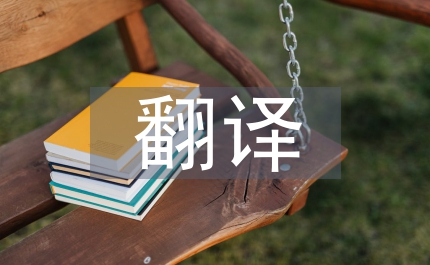雨霖铃翻译
前言:想要写出一篇令人眼前一亮的文章吗?我们特意为您整理了5篇雨霖铃翻译范文,相信会为您的写作带来帮助,发现更多的写作思路和灵感。

雨霖铃翻译范文第1篇
[KeyWords]Chinesepoetry;artisticconception;BellsRingingintheRain;solution
【摘要】汉诗英译是否成功就在于能否成功的传达意境。要成功的传达意境是不容易的,许多好的汉语诗歌翻译成英语后总是会失去原作的艺术魅力、本文首先指出:意境是通过形象化的情景交融的艺术描写,能够把读者引入到一个想象的空间的艺术境界,意境传达的困难在于中西方存在着诸多差异,不同的历史文化,风俗习惯和思维定势都使汉语诗歌的意境传达成为一个难题,本文以《雨霖铃》的译文为例,分析了这首诗歌意境传达的困难,接着通过《雨霖铃》的两种译文对比提出了意境传达的三种有效方式:传情达意,挖掘意象,激发联想。最后作者提出,这只是三种有效的方式,而不是绝对的方式。
【关键词】汉诗英译;意境;《雨霖铃》;方式
1.Introduction
"Poetryisasuperartoflanguage.”[1]Awell-knownstatementismadebyRobertFrost“Poetryiswhatgetslostintranslation”.[2]PoetrytranslationisadifficulttaskanditisespeciallytrueintheChinesepoetrytranslation.“Indeed,poetrytranslationisacreativetask.”[3]BurtonRaffelsays,“Thetranslatedpoemshouldfirstbeanewpoem,agoodone,andshouldbethefavoroflife,insteadoflifelessacademicaccuracy.”[4]TheEnglishversionsofmanyoutstandingChineseclassicalpoemswhicharegentlybeautiful,vigorousanddeepusuallycannotpresenttheoriginaltasteandflavorofthepoetry.Manyfamoussayingsandbeautifullines,whichenjoygreatpopularityduringhundredsofyears,maketheChinesereadershaveadeepsympatheticchord.Butforeignreaderscannotunderstandthemactually,ortheymayevenfeelbewilderedandthemostimportantreasonisthatthetranslationofChinesepoetryislackoftheconveyanceofartisticconception.ThesuccessoftranslationofChinesepoemsdependsonwhetheritcanapproximatelytransmitartisticconceptionofChinesepoemsandleadthereadersintoaspaceofimagination.China’spoetaswellasliteraryandtheoreticiansmostlythinkthatthegreatestachievementofpoetrycreationliesinartisticconception.Itisthesoulofpoetry.Thenwhatonearthisartisticconceptionofpoetry?
1.1Thedefinitionofartisticconception
Artisticconceptionisakindofidealartisticstate,whichcanleadreadersintothesituationandemotionofapoem.Theblendofsituationandemotionisthebasiccomponentofartisticconception,whichisinvolvedintwoaspects,oneistheobjectiveofimagesinlife,theotheristheidealsubjectivecreationofthepoet,wecalltheformeroneas“jing”,andthelateroneas“yi”.Therefore,artisticconceptionistheunifiedentityofthetwoaspects.[5]
ArtisticconceptionisoneofthemostimportantaestheticconceptionsinancientChina,whichcanbetracedbacktoTangDynasty.InhisTheStyleofPoetrypoetWangChanglinfirstlyputforwardartisticconceptiontogetherwith“物境”“情境”(twoofthreelevelslikeartisticconceptionusedtodescriberespectivelytheobjectandthecircumstancesofapoem).[6]Althoughheproposedthethreelevelstogether,hedidn’tpointouttherelationship.Jiaoran,apoetandamonkaswell,oncepointedouttherelationsbetweenYi(image)andJing(situation).Hethoughtthatthefeelingsofareadertoapoemstartfromitssituation.[7]LiuYuxiwhocarriedonJiaoran’stheoryadvancedthatwecansayinTangDynasty,theAestheticSchool---theleadingschoolofpoetrywhichanalyzespoemwithartisticconception,wasformed.[8]AndinQingDynasty,WangGuoweigaveadeeperresearchontheconnotationandcreationofartisticconception.Ashesaysinhis“CommentsonciPoetry”,“Notonlycanliteraturemotivatethewriterhimself,butalsoitcantouchtheheartsofothers.”[9]MaoDunthenthoughttheconnotationoftheliteraturetranslationisthetransmissionoftheidealcondition.Hesaid"theliteraturetranslationistotransmittheartisticidealconditionoftheoriginalworkinanotherlanguageandmakereaderbeinspiredequally,affectedandgetthebeautifulfeelingwhentheyreadtheoriginalwork.[10]
1.2.Thedifficultiesoftheconveyanceofartisticconception
Formanyyears,lotsofChinesescholarsaswellasforeignresearchersputtheirefforttodothearduousworktotranslateclassicalChinesepoemsintoEnglish.Andamongtheirworks,thereisnolackofexcellenttranslation.Asamatteroffact,justthroughthewonderfultranslationofsomeexcellenttranslator,alotoffamousclassicalChinesepoemshavewontheirworldreputation.However,asakindofartisticappreciation,weusuallyhavealittlepitythatthetranslationofChinesepoetrystillcannotexpressartisticconceptionwhenwereadastheChinesereaders,lotsofChineseclassicalpoemshavelosttheiroriginalromanticcharm,completeinformation,three-dimensionaleffect,andthestatethatcanleadthereadersintoaindefiniteimagination.ItisnotsurprisedtoseethatmanyscholarsconsiderthetranslationofChineseancientstyledpoetrytobeanunsuccessfulfieldsofar.Wecanseethatevenifsometranslationsdisplaythecontentofpoetry,theyfailtotransmit,interpretthemood,theimage,andthesituationofpoetry.BecauseofthehugedivergencebetweentheEastandtheWest,itisimpossibletoexpresscompletelytheprimarytasteandartisticconceptionofChinesepoetrytoeveryreader.
Thereasonisthatthedifferenthistoricalcultureconnotationsanddifferenthabitsandcustomsaswellasdifferentthinkingmethodsareformedintheaspectofwordsandexpressions.
TherenownedtranslatorMr.YangXianyihassaid:"Therearemanyotherfactorsconstitutingcertainmeaningsinoriginaltext.Itissimplynotimpossibletotransmitthesemeaningsforthepersonsunderdifferentcultures.[11]Forexample:theChinesereadershavesomeassociationspontaneouslywithweepingwillowinaChinesepoetry,itisimpossibletocausethiskindofassociationnaturallyifitistranslatedintoanotherlanguage.Inmanypoemstheterminology(poemlanguage)oftenhastheirculturalhistoricalbackgroundcausingthereadertoassociatesufficiently.[12]Thereisnofinaltranslationforanytranslationispartialsinceitishardlypossibleforanytranslatortoseekbalancebetweenvariousrequirement.[13]Ofcourseitcontainstheconveyanceofartisticconception.
2.TheanalysisofBellsRingingintheRain
Here,theauthorwillprobehowtotransmitartisticconceptioninthetranslationofChinesepoetrybytheEnglishversionofBellsRingingInTheRain.
2.1ThecommentofBellsRingingInTheRain
LiuYong’poemsaregoodatdescriptionofdetails,andwritteninapithystyle.Thispoemexpressesthepartingfeelingsanddescribesthesceneofpartingandthepainfulmood.Theemotionisalsoverysentimental.ThispoemisofLiuYong’srepresentativeworks.Thefirststanzadescribesthepartingscene,theauthordescribesthecicadachillily,andtwoloveswerepartingintheroadsideshelter.Theboatwasurging.Theywerereluctanttopart,handinhandwithtearfuleyes,sobbingwithoutaword.Themistywavesinthegreatdistanceandthedistantskyalsoappearedsoheavy.Inthesecondstanza,theauthorsighedwoefully:partingletsthehumanbesadsincetheoldtimes.Thelongertheypart,thesaddertheyfeel.Evenifthereisbrightdaysandbeautifulscenery,thepoetstillcannotcheerup.
“Thecicada”,“theroadsideshelter”,“thesuddendownpour”,“thenationalcapital”“theboat”,“themistywave”and“thesouthernsky”-----theseimagescomposedthedeparturepictureofgloomycolor,brimwiththethickdeepsorrow.TheChinesereadercanfeeltheauthor''''ssadmoodaftertheyreadandproducethesympatheticchord,butasaresultoftheculturalenvironmentandthebackgrounddifference,foreignreadersmaynothavesimilarfeeling,norcantheyinducetothisdignifiedatmosphere.theChinesereadercouldcarryontheverynaturalassociationtoabovetheseimages,formaseriesofpicturesinthebrains,buttheforeignreaderpossiblycannotbeabletounderstandthiscompletely.Inthesecondstanza,whatistherelationbetween“多情”and“自古”?Howtotranslate“晓风残月”?whatis“良辰好景虚设”onearth?Itisverydifficulttodescribethepainfulmoodandthedeepsorrowfaithfullytotheforeigners.
2.2ThedifficultiesoftheconveyanceofartisticconceptionofBellsRingingintheRain
Itisnotcompletelypossibletotranslatetheoriginalpoem,themoodandtheatmosphere,whichisalsoanextremelybigdifficultproblem,suchas:
Firstly,Itisdifficulttoconveytheemotioninthepoem:theemotionhereisnotpresentedexplicitlybutimpliedinthedescriptionoftheimages.Itishardtoconveytheconnotationandassociationsignificanceofimagestotheforeigners.Inaddition,theChinesepoemsusuallyconsistofseveralimages,thepoetcandisplaysomepicturesinfrontofthereadersthroughthedepictionoftheimages.InBellsRingingintheRain,“thepavilion”“eveningclouds”“willowtrees”“waningmoon”---theseimagesconstituteasceneofsorrowdepartureindrearyAutumn.Itisnoteasytoselectproperwordstoconveytheimagesaswellassuitablewordstoconnectthemintheprocessoftranslation.Finally,InBellsRingingintheRain,Chinesereaderscanassociatethewavingwillowtreesandwaningmoontothereluctanceofdeparture.ItishardtobringthesimilarfantasytoreadersinEnglishversion,becausesomeimagecannotarousethesameassociationtotheforeigners.Thereisalsoonepointthatweshouldnotice:theconveyanceofartisticconceptionisacommonproblem,sometimeseveniftheversionembodiesthecharmoftheoriginalpoem,theforeignersmaynotunderstanditcompletelybecauseoftheculturaldifferences.JustastheforeignerscannotunderstandtheloveofLiangShanboandZhuYingtai,Here,theauthoronlywouldliketodiscussthewaystoconveyartisticconception.
3.Threestrategiestoconveyartisticconception
Tobeexact,ZhaoZecheng’sartisticconceptionincludesthreeaspects:Qing(emotion),Jing(situation),andimagination.Tocounterthesethreeaspects,artisticconceptioncanbeeffectivelytransmittedtoreadersbythefollowingthreemeans:first,toexpressamorousfeelingsandideas;second,tounearthimages;finally,tostimulateimagination.[14]
3.1Expressfeelingsandideas
WhendoingthetranslationofChinesepoems,weshouldfirstlymakeclearthemainideaoftheoriginalpoem,thesituationsetinthepoemandideasandfeelingsthattheauthorwantstoexpress,otherwise,wedonottranslatebutcreatepoetry.
InancientChina,therearethesayingslike“idealcanbeconveyedbypoetry,and‘poetryisstemmedfromemotions.”[15]WangGuowei,anaestheteinmoderntimes,indicatesthat‘onlywhenapoetisabletoreflectthereallifeandexpresshisrealfeelingsbyhispoemhashereachedahigherlevelofpoetrycreation.’[16]Inhisopinion,thesimplenaturalscenery,suchasbirds’singing,flowingwater,flowers’blossomanddriftingcloudscannotconsistof‘Artisticconception’bytheirpoems.ThefamousliterarytheoreticianinQingDynasty,YeXiethoughtthatemotionfromthebottomofheartisoneoftheindispensableconditionsinthecreationofartisticconception,andwhetherartisticconceptioncanbeconveyedsuccessfullybythetranslationsornotdependsonwhetherthetranslatorisabletotransmitthefeelingsbetweenthelines,andunderstandpoet’mind.[17]AsEveingsaysinhis‘TranslationandSentiment’,translatorshouldnotonlytranslatethe‘tears’,the‘laughter’,the‘anger’,thereadinesstogivelifeonthebattlefieldandthevisiblethings,butalsothegrief,thehappiness,theindignation,theutterdevotionandtheinvisiblesentiment.[18]Forinstance,hereisseveralversesofBellsRingingInTheRain.AistranslatedbyRewiAlley,andBistranslatedbyXuYuanchong.
“都门帐饮无绪”
AWedrinktoeachother
BCanwecarefordrinkingbeforewepart
“饮”“无绪”thetwowordsaddanxietytotheparting,peopleusuallywoulddrinkwinewhenpartinginancienttime.Thepoetwassosadthathewouldnotliketodrinkatall.‘Drinktoeachother’inAlley’stranslationsdoesnotshowthiskindofmood.XuYuanchongtranslatesthewordsinto‘Canwecarefordrinkingbeforewepart’reflectakindofdisconsolateness,So,XuYuangchong’stranslationisbetter.Ifthepoemembodiesthepoet’emotion,theversionshouldindicateit.Letuslookatanotherverse:
执手相看泪眼,竟无语凝噎
Aweclasphands,faceswet
withtears;unabletosayanything
BHandinhandwegazeateachother’stearfuleyes
Andburstintosobswithwordscongealedonourlip
Totranslatetheemotioninthesetwoverses,wemustgraspthepsychologicalconditionofthepoet.Lookingateachother‘stearfuleyeswithhandconnecting,theywouldliketosaysomething,yetspeechlessforsobbingfinally.“执手”“相看”“泪眼”“无语凝噎”areasuccessionofwordsdescribingthehero’ssorrowandthegrief,XuYuanchonguses‘gazeat’and‘tearfuleyes’todescribethemood,andtransmittheemotion,‘burstinto’indicatestheeruptionofhispreservedsentiment,‘congealed’vividlymanifestthesadness.Obviously,inversionA‘wetwithtears’greatlyweakenstheemotionandcannottransmitartisticconceptionoftheoriginalpoem.Obviously,itisinadequatetoonlydisplaythecontent,wealsoshouldexpressthefeelingsbetweenthelinesproperly.Forexample:
多情自古伤离别,更那堪、冷落清秋节
Thatistosay,peoplealwaysfeelsadwhenpartingsincetheancienttimes.Howdoesalonelypersonliveinthischillyautumn?Herethepoetisdisplayingakindofdisconsolatemood.
Aeverhavepeoplehated
leavingtherefriends,andnow
thecoldautumnwithitssadness
ontopofitall;
BLoverswouldgrieveatpartingasofold.
Howcouldyoustandthisclearautumndaysocold
Comparedwith‘hated’,‘grieve’inBindicatesthatthepoetfeelsbrokenhearted,therhetoricalquestioncorrespondstheoriginalpoemexpressingthepsychologyofsadfeelinginthelonelyautumn,whichconformedtotheartisticconceptionoftheoriginalpoem.Obviously,Bismoresuccessfulintransmittingartisticconception.
Adoesnotdisplaytheemotion,thereforeitfailsinthetransmissionofartisticconception,but,XuYuanchongfullycomprehendsthepoet’semotionofBellsRingingInTheRain,andcarriesonthepoet’ssorrowbychoosingthewords.Finallyhesucceedsinthetransmissionofartisticconception.Transmissionofartisticconceptioniscloselylinkedwiththeemotiontransmission.Sowecanmakeconclusionfromtheexamplesabove,thetransferenceofartisticconceptionisincomplete,ifthereisemotioninanoriginalpoem,butthetranslationfailstomanifestthefeelingsintheverses,.Inordertofurthertheunderstandingtheimportanceofemotionexpressionintranslation,theauthorwouldliketogivemoreexamples:“晓镜但愁云鬓改,夜吟应觉月光寒。”(ToOneUnnamed)byLiShangyin)Thepoemdescribestheimmortallove:hecannothelpthinkingofhisbelovedforhisdeeplovetohersothathedoesnotseehisimagebutthatofhisbelovedwhilelookingintothemirror.Thetwolinesselectedinthepoemdescribethefeeling:thepoetworriesabouthisbeloved’sgrayhaironheadbutnothisownwhenheislookingintothemirror,hedoesnotfeelthechillofmoonlight,butheworriesthatshewillfeelcoldwhenheiscrooningverseatnight.ThefollowingaretwokindsoftranslationsofInnesHerdan(A)andXuYuanchong(B)
AGriefatthemorningmirror---
Cloud–like-hairmustchange;
Verseshummedatnight,
Feelingthechillofmoonlight…
BAtdawnI’mgrievedtothinkyourmirroredhairturnsgrey;
AtnightyouwouldfeelcoldwhileIcroonbymoonlight.
Adescribesthepoet’sworriesabouthisowngrayhair,andhefeelschill,whichistheliteraltranslationwithoutunderstandingthefeelingofthepoettohisbeloved.Soitfailstotransmitthatkindofsentimentinthepoemandrevealtheimmorallove.Xuyuanchongaddspersontodescribetheimmorallove,thusthereadersaremovedbythepoet’sfeelings,andgetthedeepcomprehensionofartisticconception.
Hereisanotherexample:“思君如满月,夜夜减清辉。”(SinceMyLordFromMyPartedbyZhangJiuling)Thepoetusesthemoontodescribethefeelingsofthewifethatsheisdullerdaybydaybymissingherhusband.LetusseethetranslationbyHerbertA.Giles:
Myheartislikethefullmoon,fullofpains,
Savethat’tisalwaysfullandneverwanes.
“Gilescomparesthewife’shearttothepainfulmoonthatneverwane,succeedsinconveyingtheessentialideaofhersorrow.”[19]Inthispoem,thekeypointoftheunderstandingofartisticconceptionistocomprehendthewife’semotion.SinceGilesconveythedistressofthewife’smissingvividlyandincisively,thereaderscanfeelthiskindofpains,thereforeGilessucceedsintheconveyanceofartisticconception.
Theanalysisabovesuggeststhatthetransmissionofemotionisimportanttothetransferenceofartisticconception.Ifthepoemembodiespoet’semotion,thetranslatedversionshouldindicateit,thusthereaderscangetadeepcomprehensionofartisticconception.
3.2Unearthimage.
Besidestheconveyanceofemotionsandideas,atranslatorshouldalsopayattentiontotheimages.Theimagereferstotheobjectinthepoetry,whichreceivesubjectivesentimentoftheauthor.Settingsun,fragrantgrass,weepingwillow,songofthebirds,cicadachirpingandsoonarethecommonlyemployedimagesinancientChinesepoems.Usually,apoetdoesnotrevealthesentimentstraightlybutawakenourmemorybythedescriptionoftheimageandstimulateourfeelingandcauseoursympatheticchord.[20]Preciselytheauthorrevealsubjectivesentimentbytakinganddescribingtheimage,thereadercanentertheartisticconceptionofpoetry.
Theimageistheessenceoflanguageofpoem.“Imagemodelcapturestheessenceofpictureinproseorinpoetry.”[21]Thepoetsalwaysutilizesthevisualizedlanguagewhichcanstimulatethereader’simaginationandtheassociationtodescribetheimageintheliteraryworks,iftheliteraryfigureisfresh,thentheexquisiteartisticconceptionwillappear.Thetranslatorshouldpayattentiontothetransplantationoftheliteraryfigureandvisualizationofthelanguageintheprocessoftranslation.Thereforetheycanfullymanifestthebeautyofartisticconception.Weshouldtransmittheimagestotranslatethepoem.Imageisthebasicelementofpoems.Thebasicfeatureisthatreaderscanexperiencethefeelingsofpoetsthroughthedescriptionoftheimage.“Wemeantodefineimageastheattributeforthewholementalconceptionofaliterarywork.Insomesense,‘image’hereiscountableaseyeablelinguisticpoint,andalltheimagesinaworkformintoameaningfulwhole,whichisoftencalleditsimagery.So‘imagery’isuncountableasaninseparableentitythatcanonlybeperceivedfromtheentirework”.[22]
Thereareseveralimagesinthispoetryasfollows:cicadas,showers,heavycloud,southernsky,willowtrees,waningmoon.“Theseobjectstobedescribedareneverselectedatrandom,butarethemanifestationofthepoet’sshrewdpowerofobservationanduniqueartisticview”[23]Theseimagesareobjects,butthepoetrendershisemotiontothemthathasbeenthesymbolofdepartureanddistress.Hesetoffthepartingatmospherebythedescriptionofobjects,thusthereaderswillportrayachillanddrearypictureasiftheyhearthesingingofthecicadasandseethepartingscene.Thenhowdothetranslationsgivethereadersthesameexpressionbyunearthingimages?Itisrareforustofeelcoldanddrearywhenhearingthesingingofcicadas,whilethepoetuse"寒"and"凄"todescribeit,forthepainfromthebottomofhisheart."寒"and"凄"uncoverdirectlythepoet’smood,thepersonhavetopartwithhisbelovedandfeelsthecoldnessoftheoutsideworld,whichishisinnermostfeelings.ThefollowingtranslationsarealsopresentedbyRewiAlley(A)andXuYuanchong(B):
ANowcomesthenoteofthecicada,mournfully;
BCicadaschill
Drearilyshrill
ComparedwithRewiAlley’s‘mournfully’XuYuanchong’s‘Cicadaschill’describesthecicada''''scondition,"drearilyshrill"corresponds"凄切"theyestablishedabasicmainkeyfortheentirepoem----cloudyandcold,"drearilyshrill"furtherexaggeratedthisatmosphere.So,“chill”“drearily”describetheprocessofpsychologyandtransmit‘artisticconception’of“寒蝉凄切”.Pavilionisconsideredasasymbolofparting,suddenshowermaybeconsideredasasymbolofthetearsfallingfromtheireyes.Lookattheverses:
对长亭晚,骤雨初歇
Aatourpaceforparting
eveningfalls;therainstormthatbroke
hasclearedaway;
BWestandfacetofaceataneveninghour
Beforethepavilion,afterasuddenshower
WecanseeRewiAlleyomitstheimageofpavilion,whichisveryimportanttotheconveyanceofartisticconceptionasasymbolofparting.InancientChina,peopleusuallypartinpavilion,soChinesereaderscanassociatethepavilionwithdeparture.AndXuYuanchongreservestheimageofpavilionandshowerusing“before”and“after”toconnectthetwosentences,sothatweseethenaturalsceneryandhumanfeelingswellblendedinthebeginningofthepoem.[24]So,Itdoeswellatthetransitionoftheartisticconception.Inthispoem,theimageoftheboatwaitingforthepersondescribesapictureofalonelysail.Theverse:
方留恋处、兰舟催发
Atheboatmanurgesdeparture
Bwearelingeringlate,buttheboatiswaitingforyoutodepart
RewiAlleyonlyuses“boatman”omittingtheimageofboat,andXuYuanchong’stranslationdescribesapicture:twopeopleareloathingtopart,theboatisurgingapersontoembarkquickly,wecanguessthattheboathasbeenwaitingforalongtime.Thepictureofalonelysailisthesymbolofthepartinglover,carryingthevisualfeeling.AndBisbetteratthetransitionofartisticconceptioncomparedtoRewiAlleythatisonlynarrating.Inthispoem,cloudandskyalsoaresymbolical,theheavycloudisthesymbolofhisheavyheart,andtheboundlessskyisthesymboloflongdistance.[25]Theoriginalversesandtranslationsareasfollows:
念去去千里烟波,暮霭沉沉楚天阔。
AandIknowthatsoonIshallbefar
fromhere,overthehills;
atnightamistwillcome
downfromheavens,andsoon
IwillbeinHupeh,where
skiesarehigh,andgroundlow;
BYou‘llgoyourwayfar,faraway,onmilesandmilesofmistywaves
wheresailtheships,andeveningcloudshanglowinboundlesssouthern
skies
Thetwoimages“暮霭”and“楚天”shouldbetranslated.RewiAlleydoesnottransmittheimage:cloud,and“skiesarehigh”doesnotdescribetheboundlessoftheskies.Thereforehistranslationweakenedtheeffectofthetransitionofartisticconceptionoforiginalpoemgreatly.Intheoriginalpoemthefirststanzabeginswithanimageandendswithanother,bothrevealthegriefofparting.[26]Thereforeintranslationthereshouldbethetransferenceofthevividimagetoletthereaderfeelthepoet''''semotionthroughtheimagestounderstandtheartisticconceptionofthepoem.
Asweknow,InaChinesepoem,therearealwaysmanyimages;thesevividimagesbringthebeautytopeople.Inordertoachievethesimilareffect,thetranslatorshouldcarryontheappropriatedescriptiontotheimages.Forexample,“小楼西角断虹明,栏杆私倚处,遥见月华生”(ImmortalAttheriverbyOuYangxiu)portrayabeautifulscene:thebrokenrainbowappearsafteraheavyrain,twopersonsareleaningonrailswatchingtherisingmoon.TeresaYee-whaYutranslatesthelinesinthisway:
Acrossthewesterncornerofthe
Smallhouse,abrokenrainbowhangs
brightly,asIrestonthebalcony,
awaitingmoonrise.
Theimageoftheoriginalpoemisbrokenrainbow,whyistherainbowbroken?TeresaYee-whaYuonlyuses‘brokenrainbow’,whichfailstomanifesttheestheticsenseofthemoonraisesslowly,thereforethebeautyisinferiorthantheoneoftheoriginalpoem.ThetranslationbyXuYuanchongis:
Animperfectrainbowisseen,
ShutoutofviewbyWesternTower.
Weleanonrailsalone
Towatchtherisingmoon.
XuYuanchonguses‘shutoutofviewbywesterntower’,givingpeopleamorevividpicture:Abovethesmallbuilding,abrokenrainbowappears,--twopeoplearecloselyleaningintherail,watchingtheslowingrisingmoon,thephraseshutoutdescribesthebrokenrainbow,thetypicalimagematchestheimageverb,hasexaggeratedtheoriginalpoemmainkeyoftheoriginalpoem,so,comparedtoTeresaYee-wha’sYu.XuYuanchong’sisbetterintransmittingartisticconception.
Theanalysisabovesuggeststhatunearthingimagesisoneofeffectivewaystoconveyartisticconception,ofcourse,inthetranslationtechniquesofimage,apartingfromunearthingimages,thereareotherwaystoconveytheartisticconception,suchasfootnotingandparaphrasing,whichthisarticleonlydiscussesoneofeffectiveways.
3.3Stimulateimagination
Intheauthor’sview,theconnotationofstimulatingimaginationisthatifthepoetleavesagreatspaceofimaginationtothereaders,soshouldthetranslator.Itisofgreatimportanceforthetranslationstostimulatethereaders’imagination.JustasXuYuanchongpointsoutinhisNewConceptofTranslationinNewCenturythelowstandardofliterarytranslationistoresembleorreflectthetruthoftheoriginalpoems,whilethehighstandardistokeepthebeautyofpoemsinsourcelanguage[27]Thetranslatorshouldtryhisbesttobringtheadvantageoftargetlanguagesintofullplay,whichmeansmakingfulluseofthebestformofexpressionoftargetlanguageaswell,andtomakepoemsunderstoodfinally.Thetranslationsofliteraryworksshouldbewonderfulandsplendid.Althoughwecanreadorlistentotheliteraryworks,wecannotvisualizethemlikewatchingpicturesorgetauditoryimageslikelisteningtothemusic.Therefore,iftheliterarylanguageisdull,tediousandinsipid,itcannotstimulatetheimaginationofreaders,thuscannotconveyartisticconceptiontoreaders,letaloneletthemgrasptheartisticimagesintheoriginalworks.Itisthetranslators’responsibilitytotakeadvantageoftargetlanguagetoreachthetranslationtostimulatereaders’imaginationfinally.
ThefollowingisanotherexamplefromBellsRingingInTheRain:“今宵酒醒何处?杨柳岸晓风残月。XuYuanchong‘stranslationis
Wherewillyoubefoundatdaybreak
Fromwineawake?
Mooredbyariverbankplantedwithwillowtrees
Beneaththewaningmoonandinthemorningbreeze.
Thepoemaskswherehewillbewhenhewakesuptomorrowmorning.“willowtrees”and“Beneaththewaningmoonandinthemorningbreeze.”stimulatethereaders’imagination,andmakethereadersimaginethescenebythemselves.Forexample:howisthepoet’sconditionwhenheawake?Andwhatwillhebethink?Differentpeoplehavedifferentimages.Peoplecanimagethesceneofthepoetawakinginthemorningaccordingtotheirownunderstandingofthepoem.“Moored”givethereaderslargespaceofimaginationthatistheneedtotransmitartisticconceptiontoreaders.
Fromtheauthor’spointofview,stimulatingimaginationplaysaquiteimportantroleintransmissionofartisticconception.Manytranslatorsnoticethepointintheprocessoftranslation.Forinstance,therearetwoversesintherenownedpoem"SongofaPipaPlayer"(琵琶行)byBaiJuyi:“大弦嘈嘈如急雨,小弦切切如私语;嘈嘈切切错杂谈,大珠小珠落玉盘。”ThetwoversesdescribethemusicbythePipa.“Itisdifficulttodescribeabstractmusicinwords,butBaiJuyicomparesitinturntoapatterningrain,topearlsdroppingonaplateofjade”[28]whichgreatlystimulatethereaders’imagination,“sothatyoucannotonlyhearitbutsometimesevenseeitbeforeyoureyes”.[29]HerearetwoversionsrespectivelytranslatedbyC.Gaunt(A)andXuYuanchong(B)
AThegreatstringswithacrashresound,
Aswhentherain-stormstrikestheground;
Thesmallstringswhispermanifold,
Likesecretconfidencestold;
Andthenthevibrantchordsoutfling
Amingledcrashandwhispering,
Likeshowerofpearls,somelargesomesmall,thatonajade-dishpatteringfall.
BThethickstringsloudlythrummedlikethepatteringrain;
Thefinestringssoftlytinkledinamurmuringstrain
Whenminglingloudandsoftnotesweretogetherplayed
‘Twaslikelargeandsmallpearlsdroppingonplateofjade
C.Gaunt’s‘therain-stormstrikestheground’;‘whisper’‘likeshowerofpearls,somelargesomesmall,’andXuYuanchong’s‘patteringrain’‘murmuringstrain’‘murmuringstrain’allstimulatethereaders’imaginationandconveyartisticconceptionofthepoeminsourcelanguageaswell.Theoriginalpoemdoeswellinstimulatingimagination,sodoesthetranslation.
Stimulatingimaginationisapartoftheconveyanceofartisticconception,wegetartistictreatthroughabundantassociationandfantasy,whichachievetheeffectofartisticconception.Asweanalyzeabove,thetranslationthatarousetheimaginationofreadersconveyartisticconceptioneffectively.Thereisapointwearesurethatevenifthetranslationscannotachievethecharmofthepoemperfectly,weshouldexertourgreateffortstoresembletheeffect.
4.Conclusion
Wecanfindthattheconveyanceofartisticconceptionisnoteasy.However,throughthethreemeans,westillcaneffectivelytransmitartisticconceptionbyexperiencingtheemotionandimagingtheimageoforiginalpoems.Theauthordiscussesthreestrategies:expressingfeelingsandideas;unearthingimages;stimulatingimagination.Theyarethreeeffectivewaysbutnottheabsolutemeans.Inaddition,thereisonepointthatweshouldnotice:whenweproposedrequesttothetranslators,weshouldpayattentiontothefactthatthereadersshouldbequalifiedtocomprehendthepoems’artisticconception.
References
[1]温辉.意象和意境:英译唐人绝句[D].西安:陕西师范大学,2000(04).P4
[2]闫军利.诗歌翻译的美学途径[D].西安:陕西师范大学,2003(04).P7
[3]戴伟平.诗歌翻译与现代性[D].重庆:西南师范大学,2004(04).P38
[4]蔺丽.中国古诗英译意境传达的探索[D].天津:天津师范大学,2005(04).P17
[5]姜莉.论唐诗英译的意境传达[J].沈阳师范大学学报(社科),2005(01).P112
[6]同[4].P112
[7]同[4].P112
[8]同[4].P112
[9]同[4].P112
[10]同[4].P112
[11]水小重.从东西方文化的差异看汉诗英译的困难性[J].西北师大学报(社科),1998(03).P98
[12]同[10].P98
[13]同[3].P17
[14]同[4].P112
[15]同[4].P112
[16]同[4].P112
[17]同[4].P112
[18]同[4].P113
[19]许渊冲.中诗英韵探胜[M].北京:北京大学出版社,1992.P204
[20]同[4].P113
[21]袁哲.文学翻译中审美再现的三个层面[D].长沙:湖南师范大学,2004(05).P27
[22]刘建华.古诗意境英译分析[D].长春:吉林大学,2004(05).P26-27
[23]陈月红.中国古典诗词翻译中的意境问题刍议[D].武汉:华中师范大学,2002(04).P32
[24]同[18].P370
[25]同[18].P370
[26]同[18].P370
[27]同[4].P114
雨霖铃翻译范文第2篇
一、运用信息技术创设教学情境,激发学生古诗词兴趣
运用传统的教学方法,进行古诗词的教学,学生常会感到枯燥无味。传统教学主要由教师将作者的生活或者写作背景向学生介绍,学生根据教师的介绍,一知半解地读懂古诗词的大致内容。或者教师直接将古诗词的翻译抄写到黑板上,让学生背诵。这样的教学方法,已经远远不能适应现代教育了。如果运用信息技术,创设一定的情境,让学生走进情境,在情境中感悟古诗词深刻的内涵,可使学生产生对古诗词的兴趣,从而加深对古诗词的理解。
如教学柳永的《雨霖铃(寒蝉凄切)》时,我播放歌曲《雨霖铃》,同时视频展示歌词,也就是全词的内容。学生被优美的音乐深深陶醉,沉浸在优美的情境中,自然而然地就感受到了词的魅力,从而急切地想要进入词的学习中,理解词的内涵,领悟词的情感,了解词人的生活背景、身世,总之,学生对词的学习产生了浓厚的兴趣,整个课堂教学,学生学得轻松、愉快,课堂气氛很活跃。
二、运用信息技术再现古人生活,感悟作者的思想感情
古诗词有许多内容,被拍成了电影、电视片或者短剧,如果能够利用这些教学资源,为教学服务,那将会大大提高教学效率,有利于学生理解古诗词。如教学《短歌行》时,为了让学生加深对曹操的认识,感悟其丰富的精神世界,加深对词的理解,我用视频展播电视短剧《三国演义》中的曹操吟诵《短歌行》的片段,让学生进行交流、诵读,从而让学生了解了曹操的文才武略,知道曹操不仅是一个政治家、军事家,更是一个文学家。
三、运用信息技术进行配音朗诵,促进古诗词的理解
配音朗诵是古诗词教学中常用的方法,配音朗诵往往有现成的录音,标准的朗诵,不仅让学生学会朗诵,更重要的是从朗诵中,感悟出古诗词的韵律美、音乐美、节奏美,也便于学生对整个古诗词的理解,而且也能够提高学生欣赏美、鉴赏美的能力,使学生学会有感情的朗诵,学会断词、断句的方法,深入理解古诗词的深刻内涵,培养想象力,产生创新的思维。如教学陶渊明的《归园田居(其一)》时,我播放配乐诵读,要求学生在聆听的过程中给生字词注音,同时想象诗歌所描绘的景象;接着要求学生跟着音乐读,要求学生在模仿中,体会诗人朴素、平淡、自然的语言风格。
四、运用信息技术拓宽师生视野,学会鉴赏古诗词
以网络为核心的信息技术飞速发展和进步,网络上有丰富的教学资源,平时教学中,教师要有意识地浏览网络,经常浏览网络世界,拓宽教师的视野,学生也应该经常上网查阅资料,学会收集资料,自主获取知识。教师可以将自己在网络上收集到的有用的教学资源,告诉学生,让学生在网络上进行学习,让学生少走弯路,使学生欣赏古诗词的能力得到训练和提高。学生可以根据自己的喜好,通过网络自主学习,选择高效学习古诗词的方法,然后归类整理,为将来更好地学习古诗词打下厚实的基础。运用网络进行教学,可以让学生平等地参与到学习过程中,在学习中获得知识,培养自学能力。运用网络进行学习,也使得课堂更加开放和灵活,教师要敢于放手让学生在网络上进行学习,给予学生网络学习的机会,发挥信息技术的网络优势,互动学习,从而提高教学效率,使得学生在自学中,获得了自信,体验到成功的喜悦,身心得到全面的发展,个性得到张扬。
雨霖铃翻译范文第3篇
一个文学家、诗人、艺术家,对于生活的认识往往是多角度、多层次的,而且还带着浓厚的主观感情,以至于对同一事物,不同的作者站在不同的角度,用不同的方法表现出来则有不同的特点:或豪放,或抑郁;或雷霆万钧,或幽咽流泉;或悲壮苍凉,或凄婉含蓄;或雄奇俊逸,或翩若惊鸿、矫若游龙;或静若处子,娇羞内蕴……过去在初中语文教学中,我们常常对作品缺乏必要的赏析,一般停留在读几遍,了解大意,泛泛然地分析一下中心思想、写作特点上。教学古诗词,有些教师还要把它翻译成白话,这样做,让那些优秀的作品变得味同嚼蜡。
像一束花,有人只看到它红红绿绿的颜色,有人却能嗅到它浓郁的芳香,还有人能够由一束花看到百花齐放的花园,看到五彩缤纷的春天。鉴赏文学作品,要借助读者的想象思维,对作品进行主观的艺术加工,或者凭借自己对作品的理解,借鉴前人的观点对所读作品作出一定评价。通过对相同主题或题材而不同作者的作品进行比照赏析,或者把相同作者的不同题材的作品进行比照赏析,就可以发现不同作者或不同作品的风格了。
人们常常把柳永的《雨霖铃・寒蝉凄切》和苏轼的《念奴娇・赤壁怀古》进行比照,前者称为“婉约”派代表作,后者称为“豪放”派代表作。作品的豪放或者婉约和作者的性格、经历、处境及创作时的心境、情感都有一定关系。如,李白的作品绝大多数表现为豪放、浪漫,而与之同时的另一位大诗人杜甫的作品则表现出深沉、抑郁。李白一生狂放不羁,蔑视权贵,常常借酒述志,借酒抒怀,他的诗歌就运用大胆想象、无限夸张的笔调,写出了大量瑰丽的诗篇。“俱怀逸兴壮思飞,欲上青天揽明月”《宣州谢I楼饯别校书叔云》;“白发三千丈,缘愁似个长”《秋浦歌》;“斗鸡金宫里,蹴鞠瑶台边。举动摇白日,指挥回青天”《古诗五十九首之四十六》;“倚剑登高台,悠悠送春目,苍榛蔽层丘,琼草隐深谷”《古诗五十九首之五十四》;“飞流直下三千尺,疑是银河落九天”《望庐山瀑布》;“人生得意须尽欢,莫使金樽空对月”《将尽酒》等等。从以上作品可以看出李白豪爽奔放的性格。而杜甫一生坎坷,精神压抑。在安史之乱中,他颠沛流离,亲身经历和亲眼目睹了战乱带给老百姓的痛苦,在他的诗里,表现了他忧国忧民的感情,其作品风格被称为现实主义。如,“爷娘妻子走相送,尘埃不见咸阳桥。牵衣顿足拦道哭,哭声直上干云霄……”《兵车行》;“乾坤含疮痍,忧虞何时毕”《北征》;“关中昔丧乱,兄弟遭杀戮。官吏何足论,不及收骨肉”《佳人》。同样是送别,在不同的诗人笔下,有的显得豪放洒脱,有的就显得忧伤哀愁,我们熟悉的王维《送元二使安西》,“劝君更尽一杯酒,西出阳关无故人”就显得那么悲凉。对友人那么关切,那么留恋!而另一位诗人在送别朋友时,就显得特别洒脱豪迈:“千里黄云白日曛,北风吹雁雪纷纷。莫愁前路无知己,天下谁人不识君。”《别董大》(高适);“执手相看泪眼,竟无语凝噎”《雨霖铃》(柳永),这就表现得很凄婉、很忧伤。但是豪放的李白还写过“孤帆远影碧空尽,唯见长江天际流”《送孟浩然之广陵》,“浮云游子意,落日故人情。挥手从兹去,萧萧班马鸣”《别友人》;“泣与亲友别,欲语再三咽”《古诗五十九首之二十》等这些缠绵的诗句。判断一个表达同一主题的作品的风格相对容易,比如上面列举的送别诗,王维的婉约,高适的豪放,李白的缠绵,都是出于送别当时的情景和心情、被送的对象的情况等。王维送的朋友元二是从长安到西北边陲去,出阳关后就是一片荒凉的情景,再没有往日的欢乐,没有和那么多朋友在一起饮酒赋诗的惬意,被送人心情悲伤,也会感染送别者的;而高适送别的朋友董大是从边陲到内地,到生活条件好的地方去,朋友们自然要为他感到高兴的。
要分析一个作者的作品的总的风格,需要全方位考察、阅读、赏析他大量的作品。现在中学生阅读面比较狭窄(特别是农村学生),在教学中,教师要有目的地给学生推荐一些作品,提供一些有助于他们扩大阅读的资料、信息,比如要教学某个作者的某篇作品,应该先给学生布置阅读该作者的其他相关作品,或者其他作者同类型的作品,这样有比较才能鉴别。在中学语文课本中,还选了许多现、当代名家的作品和外国著名作家的作品。由于涉及面太宽,每位作者的作品入选的文章有限,在分析他们的作品风格的时候,老师需要注意进行横向和纵向的比较,把某个作家的许多作品前后纵向比较去判断他的风格,或者把他的作品跟同时代的其他作家的作品进行横向比较分析,就能判断出这个作者的风格了。或者先介绍某个作家的风格,再用一些相关的作品进行证明。
比如,鲁迅的风格是深刻、内蕴。常常以非常简洁的描写、点睛似的评论、平淡的叙述,就可以揭示一个非常深刻的社会问题,可以用《孔乙己》中“孔乙己是站着喝酒而穿长衫的唯一的人”“听人家背地里说,孔乙己也读过书……”就这么一句介绍和侧面叙述,一个深受迫害的封建知识分子的形象就跃然纸上;再如,《故乡》中对中年闰土“木偶人”式形态的描写和“豆腐西施”杨二嫂“圆规”式的体形、尖利的语言的描写,简直入木三分!而且这些人物不是简单的个体,而是代表社会的某一个阶层。纵观选入初中语文课本的鲁迅的许多作品,无不深刻、发人深省。《从百草园到三味书屋》里写美女蛇的故事,《社戏》中在平桥村的孩子们的介绍时很自然地介绍乡下的风俗,《藤野先生》中则处处都有深刻的文字,如“中国是弱国,中国人当然是低能儿……”这样看似简单的内心独白,却深刻地揭示了弱国公民受辱时内心的愤怒。
再说还有冰心作品体现的母性、茅盾的博大、老舍的平易、郭沫若的浪漫。还有当代作家毕淑敏的敏锐、张晓风的纯真……还有外国作家的作品所反映的时代特征和他们自身作品的风格。也可以由老师提示,学生在自己的课外阅读中去体会。
作品的风格一般都可以从入选到课本里的作品里分析体会到,因为课本的编者在选文章的时候,是充分考虑作品的代表性的。
初中语文教学中,根据新课标的要求,对学生赏析式的阅读也提高了标准,教师在教学过程中要培养学生分析作品风格的习惯。由浅入深,细细体会。学会分享作家写作时的那种情感体念,分享作者用浪漫、豪放或者委婉、轻柔或者热烈的风格所抒发的感情,也可以在自己的写作中展示自己的风格。
雨霖铃翻译范文第4篇
【关键词】读诗;大胆质疑;创造力
中国是诗之国,诗是中国文化瑰宝,也是中华民族精髓。特别是古诗词,千百年来,中国人在它宽广的胸怀里陶冶情操、感悟世界、了解民族历史。因此,诗歌在教材中的比重也越来越大,作为教育者,我们应当教育我们的下一代了解古诗、解读古诗,热爱中国文化。
在传统诗歌教学中,我们通常都是读古诗、翻译诗句、体会感情、背诵古诗,几个回合下来,学生读诗的兴趣全无。要知道,只是记些注释,背诵诗句,并不是读诗的根本目的,我们教给学生的不该只是“标准答案”,我们应当引导学生以新的视角、新的思维阅读古诗,从而品出诗中的韵味、读出诗中的生活、感悟诗中的生命,不拘泥于课本及参考书,甚至对传统结论大胆提出质疑。爱因斯坦有句名言:“提出一个问题比解决一个问题更为重要”。
《敕勒歌》(敕勒川,阴山下,天似穹庐,笼盖四野。天苍苍,野茫茫,风吹草低见牛羊)被称为我国古代民歌杰出代表作品,也被纳入了九年义务教材。大部分参考书注释如下:辽阔的敕勒川在阴山脚下,天空像一座巨大的帐篷,笼盖了整个原野。苍天辽远空旷,草原一望无际,微风吹倒了牧草,露出了藏在草中的牛羊。我没到过草原,但在电视和电影中看到过牛羊在草原吃草的场景,对于这样的解释总有个不明白的地方,草原的草怎能长得比牛羊高?怎能掩没牛羊呢?读了张港的《经典古诗词另类“悦读”》后才知道:草原的草本身不能掩没牛羊,能掩没牛羊的应该是些芦苇、蒿草之类植物。如果真是那些草,又长那么高,马就不能跑起来,牛羊恐怕也要常丢失。那为何诗中作者说是“风吹草低见牛羊”?我们再说说“天似穹庐,笼盖四野”。一个人若着目视前方,能看到的只能是视角前方一百多度,如何能看到像个巨大帐篷的天空笼盖着原野呢?所以我们可以推测,诗人写诗的时候,应该是躺在草地上,悠闲地啃着草根,仰望着天空,若有所思,此时正看到了半球状的天空,才有了“天似穹庐,笼盖四野”。也正是因为他躺在地上,位置低,才有了“风吹草低见牛羊”——牲畜在草地上时隐时现的一幕。总算弄清了原委,诗人正是设了一个迷让后人去猜。
王之涣的《登鹳雀楼》(白日依山尽,黄河入海流。欲穷千里目,更上一层楼)仅仅20个字的不朽之作千古流传,作为激励诗,它激励了一代又一代奋发向上的有志之士。宋人沈括《梦溪笔谈》记载:“河中府鹳雀楼三层,前瞻中条,下瞰大河。”许多人认为,作者写诗时在第二层,也有人认为诗人应该是在第三层,到底在哪一层?我们可以透过字眼探个究竟。“欲穷千里目”“欲”是想要,并非现实,而“欲”字也告诉我们作者登楼的目的是想看得更远,若是作者明知楼有三层却只登到二楼便写下“欲穷千里目,更上一层楼”,不太合逻辑,想要看得更远,直接上三楼不得了,还用得着在楼下猜想。所以,我认为作者应该是已经登到了顶楼,但还不满足,觉得看得还是不够高远,心想着要是还能再上一层楼甚至更高就好了,这才合乎逻辑。而这里的“一层楼”并非实指“一层”,而应是无数个“一层”,或是超越新的高度。这也才符合作者当时意气风发、踌躇满志的心志。
《春晓》(春眠不觉晓,处处闻啼鸟。夜来风雨声,花落知多少?)作者如此的聪明睿智,同样用20个字就道出了一个大自然蕴藏的奥秘。查看了不少参考书都将诗中“处处闻啼鸟”的“处处”注释为“到处”,若是这样,此句便译为“到处都能听到鸟儿明快的叫声”。真是这样的吗?我们可先从字里行间来捕捉一些关于作者的信息。“闻”是作者听到的,“花落知多少”则是作者的推测,这些说明作者已经醒了,但并没有马上起床出门,因此外面的世界并不是通过视觉看到的。李白的“不知明镜里,何处是秋霜”,“何处”指“何时”,译为“不知从什么时候有了白发”;柳永的《雨霖铃》“方留恋处,兰舟催发”,“方留恋处”指难舍难分的时候,“处”指时候;韩愈《早春》“最是一年春好处”显然说的也是时间。可见在古诗中“处”可指“地方”也可指“时间”。而“处处闻啼鸟”中,作者未出门,解释为“时时都能听到鸟儿的啼叫声”应该更符合作者的处境。
可见,读诗不需要多大的智慧,但不能没有自己的见解,在读诗的过程当中应当学会借鉴别人的观点,揉和自己的见解,发挥自己的创造力,因为读诗同样需要想象的翅膀。美国著名学者布鲁巴克也很精辟地指出:“最精湛的教学艺术,遵循的最高准则就是让学生自己提问题。”在诗歌的教学中,教师应鼓励学生多读诗,以创新的视角读诗,教师还应当有效地引导学生结合自己的经验大胆质疑,不可人云亦云。
诗的灵魂在于它的生活性,诗的魅力在于它的创造力。诗人同样是生活中活生生的人,我们只有用生活的眼光去读诗,用创造的想象力去读诗,才能读出诗的韵味,才能体会到中国文化的博大精深,才能达到读诗的最终目地。
雨霖铃翻译范文第5篇
关键词:预设;生成;课堂
高三语文教学主要就是复习,加之其知识面涉及广,知识点又较为零散,高考的考查方式又灵活多变,故整个复习过程对于学生来说,既乏味还不易把握。如何才能有效地开展高三语文复习,是身处高三的语文老师必须面对的难题。而我认为,解决这一难题的关键就是要提高高三语文课堂教学的有效性。
一、精心预设
精心预设是高中语文课堂生成的前提,也是提高高三语文课堂教学有效性的先决条件。具体体现在:
1.掌握学情,提前备课
语文教学的一贯宗旨都是围绕如何全面地提升学生的语文素养而展开的。基于此,高中语文教学的起点应是在掌握学生学情的基础上进行的。而身为高三的语文教师,也只有在掌握了学生的基本学情后,才能对症下药,并做好相关症结的提前备课工作。要提高高三语文课堂教学的有效性,就必须要做到提前备课。按照学期初制订的教学计划,有章有序地进行不同模块的复习,更有利于知识点的系统化。这一点,在文言文专题复习时尤其突出和重要。如,一轮复习时,梳理《种树郭橐驼传》一文的知识点,学生对倒装句“凡长安豪富人为观游及卖果者”翻译不好,了解之后,得知学生是对定语的概念比较模糊,难以划清句子成分。因而,在复习《廉颇蔺相如列传》《石钟山记》《劝学》三课时,就结合三课中“求人可使报秦者”“石之铿然有声者”“蚓无爪牙之利,筋骨之强”的定语后置句,提前备好定语后置的几种常见类型,让学生从中鉴别、分析,最终找出规律,使之趋于系统化,从而促进教学实效。
2.整合资源,明确导向
在高三语文复习课中,精心预设还体现在对教材的整合和运用上,正如在文言专题复习时,根据复习需要,对教材中的重要文言篇目进行知识点的系统梳理和巩固,有时可能只是借用某个实词的特殊用法,以唤醒学生对已学知识的记忆;或是借用某个特殊类型的倒装句式,以辅助学生对陌生文段的理解和翻译。而在进行古代诗歌专题的复习时,对教材的整合就体现得更加明显了。在这个模块中,我们不能仅仅教给学生单一的解题技巧和固定的答题模式,还要引导学生尝试着自己去归纳、整理。例如,可以让学生将其在课本中所学的诗歌,根据诗歌的内容予以归类整理,可分为:咏史怀古类有《登金陵凤凰台》《登楼》《登快阁》等,行旅闺怨诗有《雨霖铃》《声声慢》《夜雨寄北》等。让学生在归纳中明确并掌握各类型的出题类型和常用的手法,使之形成一个知识系统,再结合已掌握的解题技巧,将其内化吸收,形成能力,提高教学实效。
二、巧妙生成
提高高三语文课堂教学的有效性,还取决于课堂上的巧妙生成,同时,它也是精心预设的延伸和提高。我们的授课群体是思维活跃的学生,这就注定了我们的语文课堂教学必定是一个动态的过程,它不可能按着我们预设的轨迹来运行,相反,还总是会有很多意料之外的问题出现,因此,身为执教者要善于抓住这些契机,并结合学生的不同学习需求,将之前的精心预设和当前的意外生成有机地融合在一起,使语文课更具灵活性,从而打造精彩且高效的高三语文课堂。
1.营造氛围,巧妙生成
语文课堂是一个动态的过程,就决定了其是复杂、多变的。加之又有诸种不定性因素,再精心的预设也不可能,也不必要面面俱到。因此,在学生有了不同的看法和疑问时,教师要采用赏识教育的理念,尊重学生,肯定其表现的同时,作适当地调整,富有创造性地继续组织我们的课堂教学,顺着学生的思维角度,再创新生成与之相关联的问题,给学生一个支点,引导和帮助其理解。
2.开放问题,巧妙生成
爱因斯坦说:“有时候提出一个问题比解决一个问题更有价值。”因此,身为高三的语文教师要善于在语文课堂上创设出易让学生去探究、讨论的问题,尽量用最精练且灵活的问题,来激发学生的学习兴趣,使之不由自主地参与到课堂教学中来,从而使学生研习问题、讨论问题的热情高涨起来,在沟通交流中巧妙生成,从而提高教学的有效性。
总之,语文是一门主观性较强的学科,教师可以在每节课结束后,多与学生沟通交流,多听听不同学生的声音,将这些反馈信息整理好,再结合自己授完课后的感受,认真反思自己课堂教学中的亮点和不足之处。在反思的过程中,还要反思自己在备课时的预设哪些取得了预期的教学效果,并生成了“师生”“生生”的共鸣,教师要将这些亮点总结并记录下来,在以后的教学中继承并发扬。还要反思有哪些不足之处,是源于什么造成的,如果再讲一次,应该如何完善,并做好相关解决方案。事实证明,成功的教案不在课前,而在课后。相信只要坚持下去,执教者驾驭课堂将游刃有余,而且也能提高高三语文课堂教学有效性。
参考文献:
[1]高文.现代教学的模式化研究.山东教学出版社,2000.
免责声明:以上文章内容均来源于本站老师原创或网友上传,不代表本站观点,与本站立场无关,仅供学习和参考。本站不是任何杂志的官方网站,直投稿件和出版请联系出版社。


